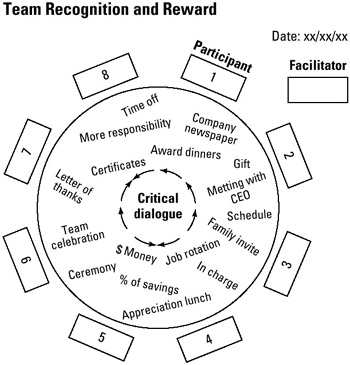Tool 50: Critical Dialogue
| AKA | Dialogue |
| Classification | Idea Genrating (IG) |
Tool description
Team participants use critical dialogue to engage in an open and meaningful flow of thought, exploring and giving serious attention to surfaced ideas. It also provides for common understanding and agreement on solutions to problems or opportunities for improvement. Additionally, critical dialogue gives an opportunity for involving all team participants in the sharing of information and the receiving of valuable freedback.
Typical application
-
To openly explore the issues and receive constructive feedback during a deep and meaningful sharing of thoughts or ideas on an issue.
-
To involve all team participants in a natural flow of conversation leading to a common understanding of the issue or problem at hand.
-
To consider ideas or a variety of possible decisions.
Problem-solving phase
| → | Select and define problem or opportunity |
| → | Identify and analyze causes or potential change |
| → | Develop and plan possible solutions or change |
| Implement and evaluate solution or change | |
| Measure and report solution or change results | |
| Recognize and reward team efforts |
Typically used by
| Research/statistics | |
| 1 | Creativity/innovation |
| Engineering | |
| 2 | Project management |
| Manufacturing | |
| Marketing/sales | |
| Administration/documentation | |
| Servicing/support | |
| 4 | Customer/quality metrics |
| 3 | Change management |
before
-
Circles of knowledge
-
Buzz Group
-
Run-It-By
-
Different Point of View
-
Fishbowls
after
-
Consensus Decision Making
-
Starbursting
-
What-If Analysis
-
Barriers-and-Aids Analysis
-
Force Field Analysis (FFA)
Notes and key points
-
Team facilitators must be careful whenever controversial issues are addressed. Conducting a dialogue about certain issues may result in debating the issues!
Step-by-step procedure
-
STEP 1 The practice of critical dialogue requires an experienced facilitator. The team or group of people seeks out someone who has experience in group dynamics and conflict resolution.
-
STEP 2 The facilitator arranges a table and chairs to form a circle to establish a sense of equality among participants and to ensure that everyone can see and hear one another.
-
STEP 3 Next, the facilitator introduces the general concept of critical dialogue, sets a time limit for the session, and asks participants to recall a good, in-depth conversation between equals.
-
STEP 4 Participants are asked to share their experience and state what characteristics of that conversation made it a good, effective exchange of thoughts.
-
STEP 5 The facilitator records these characteristics on the flip chart and asks all participants to reflect on the them.
-
STEP 6 Skillfully, the facilitator introduces a topic to the participants and allows participants to engage in critical dialogue. See example Team Recognition and Reward.
-
STEP 7 From time to time, the facilitator may find it necessary to intervene in order to clarify process steps or assist in reducing confusion or frustration.
-
STEP 8 Lastly, the facilitator closes the session by asking participants for their ideas or supporting comments and summarizes these on a flip chart for later reference.
Example of tool application
Team Recognition and Reward

EAN: 2147483647
Pages: 326
- ERP Systems Impact on Organizations
- ERP System Acquisition: A Process Model and Results From an Austrian Survey
- Context Management of ERP Processes in Virtual Communities
- Intrinsic and Contextual Data Quality: The Effect of Media and Personal Involvement
- Healthcare Information: From Administrative to Practice Databases